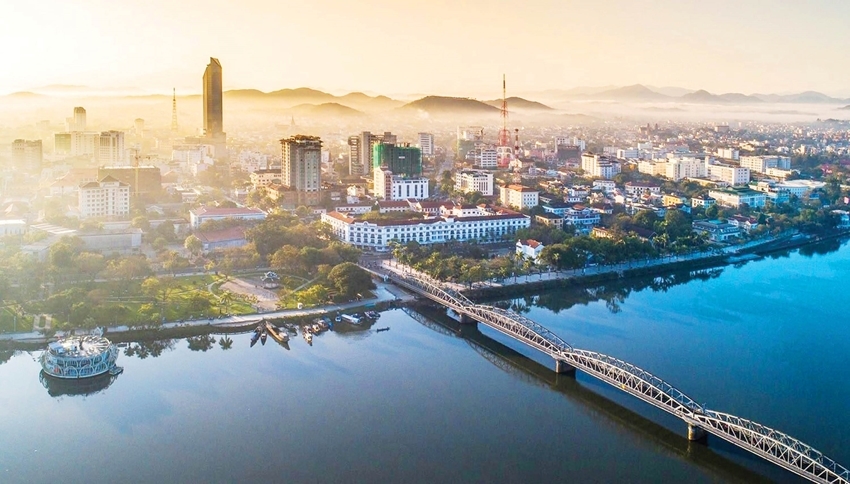1. Starting with “Hue”, the name has not been interrupted from its appearance until today. According to historical documents, from the 15th century to the middle of the 19th century, “Hue” meant a place associated with the Kim Long palace of the Nguyen lords. It had not yet become the name of an administrative unit of the country.
On July 12th, 1899, Emperor Thanh Thai issued an edict to promulgate the establishment of Hue town, which was similar to the then existing centers under the contemporary feudal state administrative apparatus, such as towns of Thanh Hoa, Vinh, Hoi An, Quy Nhon, and Phan Thiet.
After the victory of the August Revolution in 1945, the Provisional Government of the Democratic Republic of Vietnam consolidated the State management apparatus and rearranged its administrative units. At that time, the Executive order No. 77 dated December 21st, 1945 of the President of the Provisional Government of Vietnam stipulated that Hanoi, Hai Phong, Nam Dinh, Vinh, Hue, Da Nang, Da Lat, and Saigon were all designated as cities…
At the end of April 1976, 3 provinces of Quang Binh, Quang Tri and Thua Thien were unified into Binh - Tri - Thien province. The provincial capital of Binh - Tri - Thien was located in Hue City.
Currently, Hue City is a first-level city directly under the province and after many times of being upgraded and adjusted the administrative boundaries of its affiliated units, Hue city has 36 administrative units (including 29 wards and 7 communes).
The brief historical data above show that the name Hue appeared very early and was once a centrally-governed city during the Nguyen Dynasty as the capital, along with Saigon and Hanoi becoming three centers of the country.

Most people agree with the name “Hue” when the whole province becomes a centrally-governed city
In the process of building the province to become a centrally-governed city, all levels of government are now considering and collecting opinions on a name of the city in the near future.
Two options are given, including Hue or Thua Thien Hue. Through the collecting opinions and surveying people, the name “Hue” has been chosen by the majority of people so far.
Assoc. Prof. Dr. Do Bang, Vice President of the Vietnam Association of Historical Sciences, used the two words “topping” and “branding” after choosing the name “Hue” for the future centrally-governed city. He said that Hue has integrated precious material and spiritual values to create a Hue cultural tradition. That tradition both carries indigenous characteristics of a land and is inseparable from the general characteristics of the Vietnamese national cultural tradition; and at the same time, includes the mutual interference and influence among the advanced cultures of the mankind.
In reality, “Hue” is used solemnly and popularly in all aspects of the social life, such as Hue people, Hue culture, Hue tourism, Hue relics, Hue royal court music, Hue timbre, Hue Festival...
As for the name of Thua Thien Hue, it only officially appeared since 1989 in the provincial history of formation and development, after the Eighth National Assembly issued a resolution to split the Binh - Tri - Thien province into 3 provinces of Thua Thien Hue, Quang Binh and Quang Tri.
The title of “Thua Thien Hue” is not as commonly used as “Hue” and is also less known. “In the minds of the vast majority of people, whether living locally or working far away, they always identify themselves as “Hue people” with a great pride. Thus, the name “Hue” fully represents the land of Thua Thien Hue,” said Sc.D. Archt. Ngo Viet Nam Son.
2. According to the plans to establish administrative units under the centrally-governed city, Hue city will be divided into districts to the north and south of the Huong River.
Currently, the names such as Thua Thien, Ngu Binh, Thuan Hoa, Phu Xuan, Huong Giang are consulted by the competent authorities.
Through many seminars, leaders of the Department of Home Affairs affirmed that these names are based on the research and selection of famous names, imbued with cultural identity in association with Hue land.
The name was formed on the basis of history, recognized by scientists and researchers and experienced over the time and outstanding historical events associated with the land of Thua Thien Hue. It is relatively representational for a land and an area divided into administrative units. This criterion is closely related to the popularity, which means that it must be known by the people in the area as a title under their “property”.
In addition, it is necessary to ensure the proportionality and compatibility between the historical origin and the representative of the name with the level and size of the named administrative units. It should avoid using names that are highly universal, representing a macro image or a large area of land to name a smaller administrative unit. Or, names with little influence and a narrow scope should not be used to name a larger administrative unit to ensure the harmony of the district names.
From the history to the present, the title of a locality has always been the pride of the people. That name connects emotions, preserves traditions, and inspires the community. The roadmap has been set out and the naming of new administrative units is being widely popularized among all classes of people.
Determining the names of administrative units is only a part of a process of “transforming to the centrally-governed city”, but this is an important job, containing both immediate and long-term cultural visions...